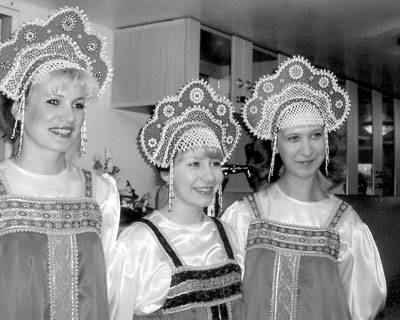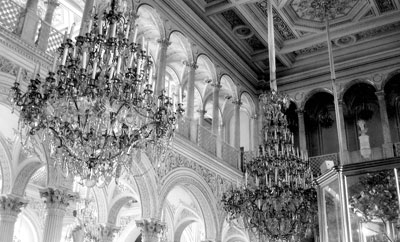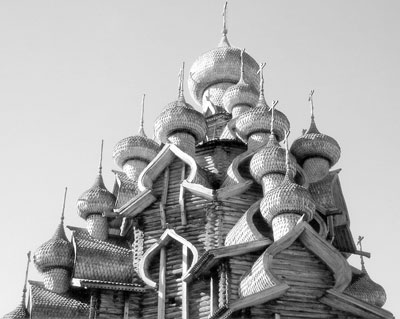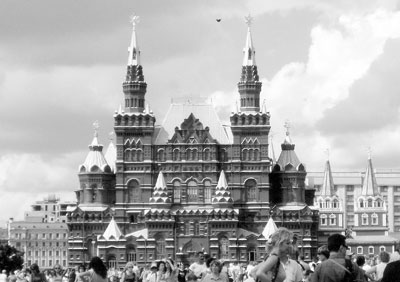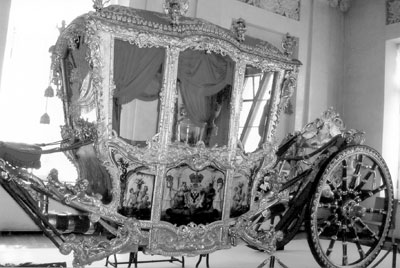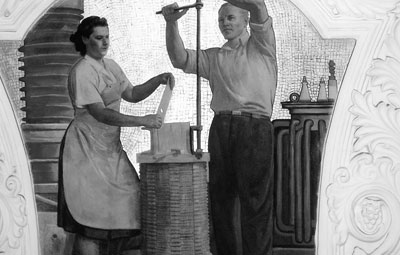St. Petersburg to Moscow — a Russian waterways cruise
by Marilyn Lutzker, Sunnyside, NY
On Peter the Great Cruises’ “Russian Waterways” cruise, I spent four days in St. Petersburg and three in Moscow and traveled 633 miles on three rivers, three lakes, a reservoir and a canal.
St. Petersburg
Every trip is made up of both the wonders one expects to see and the wonders which are unexpected. In St. Petersburg, the church with the improbable name of the Church of Our Savior on Spilled Blood came as a total surprise to me.
With its onion domes glittering with swirling patterns encrusted in turquoise, its moldings and pinnacles gleaming with gold leaf, its decorative arches and windows and its panels adorned with multicolor mosaics, the outside of this building is a fairy-tale extravaganza of color and shape.
Traditional Russian Orthodox churches do not use stained glass or sculpture to educate worshipers about the Bible and the lives of the saints. Rather, the walls themselves carry the stories. Usually, the illustrations on the walls are frescoes; in the Church on Spilled Blood, glimmering mosaics cover the walls from floor to ceiling.
Built between 1883 and 1907, the church marks the spot on which Alexander II was assassinated (thus the name).
Museum visits
The Hermitage has long been a “must see,” for me, and it lived up to my expectations. With thousands of works that could only have been amassed by a ruler intent on building an unrivaled art collection, the Hermitage offers masterpieces for every taste. As expected, Michelangelo, Leonardo, El Greco, Raphael and Rembrandt vied for my attention with masterpieces of Greece and Rome.
But even here there is the unexpected. Early in the 20th century, Russia had private art collectors whose tastes went beyond that of the Empress Catherine. Their astute purchases prior to the revolution added Monet, Gauguin, Matisse. Picasso, Léger and Rodin to the already overwhelming wealth of the Hermitage.
When I visited in late July ’05, the museum was overcrowded with tourists. I was happy to follow along with our tour guide, as the building itself is huge, the arrangement of galleries, unclear, and information in English, scarce.
The Russian Museum was on my must-must-see list, and I opted to visit it alone. Magnificent!
The first four rooms are devoted to icons whose somber-faced Madonnas and saints staring out from golden backgrounds may not be to everyone’s taste, but I love them.
They are followed by seemingly endless galleries of romantic, immaculately detailed, often immense examples of 19th-century Russian academic painting. Looking at these landscapes, genre scenes and depictions of historical events makes it easy to appreciate the truly radical nature of the paintings hanging in the late 19th- and early 20th-century galleries.
Unfortunately, St. Petersburg shows its history on its face as well as in its magnificent museums. During the 900-day Siege of Leningrad (1941-1944), more than two million people died and two-thirds of the city was destroyed. It was hard to forget this catastrophe as I looked around the city.
Although the museums and many 18th- and 19th-century palaces are well maintained, between the palaces there are buildings with peeling paint, cracked concrete, chipped stucco and cardboard-covered windows. Massive Stalin-era apartment blocks looked especially decrepit and sad because of their size.
Cruising to Moscow
We left St. Petersburg at 5 p.m., arriving in Moscow at 1 p.m. seven days later. We stopped at six places along the way.
Unaccustomed to cruises, I was pleasantly surprised that I didn’t become restless and bored during the trip because there was so much to see on the waterways and do on the ship.
We passed many river boats just like ours (all of which make the same stops!), as well as fishermen in rowboats, children swimming, campsites and villages with small houses, golden-domed churches and dachas — some, small wooden shacks but many, imposing 2- and 3-story structures with attached docks and boathouses. There was also ample evidence of industry: cement works, barges full of sand and so many log-laden barges that I fear for the future of Russian forests.
It’s hard to explain why going through a lock should be so endlessly fascinating, but it is — and we went through 16 of them. I was intrigued each time I watched the water (and the ship) slowly get higher or lower. The combination of sensations — the movement of the boat, the sound of rippling water, the gears moving slowly and the gates opening and closing — was pleasantly mesmerizing.
Shipboard activities were varied: movies at night, piano music in the bar until very late (I never managed to get there), and classical and folk concerts. The onboard entertainers, two singers, a pianist, a balalaika player and an accordionist, were extraordinarily good. There was also a tea ceremony, a captain’s dinner, a blini and caviar mid-morning snack and Russian language lessons. And every day there were excursions off the boat.
Traditional religious architecture
While St. Petersburg’s architects were constructing masterpieces with surfaces of gold leaf and multicolor mosaics, their country brethren were using unadorned wood. Which is the greater achievement?
In 1714, on the tiny island of Kizhi in Lake Onega, craftsmen erected the Transfiguration Cathedral, a towering achievement of complexity and, within, simplicity.
Twenty-two cupolas composed only of unpainted aspen-wood shingles sit atop gables which echo the shapes above them. A multitude of gables and moldings cascades down the simple log cabin construction of the base of the building.
Built entirely without nails, this is the epitome of Russian wooden church architecture. Watching its simple wood shingles shimmer in the sunlight, I didn’t miss the golden domes and colorful mosaics of the urban churches.
Examples of wooden architecture across the Russian North have joined the cathedral and the nearby Intercession Church to form the State Historical, Architectural & Ethnographic Preserve of Kizhi, now a UNESCO World Heritage Site.
Wandering the spacious grounds of the 15th-century Kirillov Monastery outside of Goritzky (I had abandoned the guided tour), I found four black-clad men singing in a small domed anteroom whose acoustics magically magnified their voices. There, I was introduced to Russian Orthodox hymns.
While large tour groups kept coming in, going out and being replaced by the next large tour group, I remained seated on my stone bench, reveling in the sounds. We would hear similar groups in other monasteries later on this trip, but the four musicians of the Kirillov Monastery were the best.
Later, we walked around the tiny village of Goritzky with its traditional wooden houses bordering the town’s only street. Friendly villagers smiled and beckoned us in to see the small crowded interiors of their houses.
Along the Volga
Our itinerary included many churches. Although each was a bit different, they all included gilded domes, interiors covered with traditional frescoes and grim-faced saints peering down from the golden-framed iconostasis on the altar wall. Most were more like museums than working religious organizations.
The church and nunnery of Bogo-yav-lensky, located in the center of this small city, is a functioning church, and the contrast was startling. Here the hustle and noise was from worshipers, not tourists. People were standing in the middle of the floor, in the corners and along the walls, some worshiping quietly in front of icons while others crossed themselves and lit candles whose burning odor filled the building. A small group gathered around the priest conducting a service for the dead.
The walls were whitewashed because the church cannot afford to restore the ancient frescoes.
In Kostroma, as at every stop we made, there was an outdoor bazaar with dozens of stalls and shops, all selling mostly the same things. By this time, I was really tired of looking at Russian nesting dolls!
However, Kostroma is the center of Russia’s linen industry and, judging by the appearance of the ladies at dinner that night, the linen blouses and sweaters of Kostroma’s bazaar were too tempting for most to resist!
Moscow
Our next stop was Moscow, a lovely city. It is busy, lively, clean and well kept. The architecture is surprisingly varied: 18th-century palaces, Stalin-era apartment blocks and skyscrapers, buildings in traditional Russian style and many impressive 20th- and 21st-century structures. There are five synagogues, two Catholic churches, more than 100 McDonald’s and 500 Orthodox churches, most with golden domes piercing the skyline.
Red Square — it was hard to believe I was really there! Cognizant of all the history which has taken place in that spot, I was still amazed by its size and by the variety of buildings which define its space. From the starkness of the 15th-century Kremlin walls to the opulence of 16th-century St. Basil’s, from the white trading arcades of the 19th-century GUM department store to Lenin’s pink marble tomb, this square reflects centuries of Russian history.
Moscow museums offer a panorama of Russian and Western European art. The Armory in the Kremlin is world famous for its collection of decorative arts, rivaling that of the Victoria & Albert Museum in London. Fabergé eggs, jeweled crowns, silver, porcelain, imperial thrones of velvet and gilt, and opulent Baroque rooms all add up to more than what one pair of eyes can comfortably encompass in a single visit.
The Pushkin Museum, despite its very Russian name, is a world-class museum of European art with an unparalleled collection of early modern art. I have never seen so many Gauguins in one room or such a striking and varied collection of Matisses.
But the Pushkin has its anomalies. Having started as a study collection for art students, holdings include plaster casts of some of the world’s masterpieces, like Michelangelo’s “David” and the portal of Chartres Cathedral!
Lubavitch Synagogue
Every day of the trip had an included tour — some a half day, some a full day and sometimes a choice between two destinations — but the ship’s tour director was always willing to arrange for a car and driver (although not always English-speaking) to take passengers to a place not on the itinerary. We decided to visit a synagogue in Moscow.
We thought our driver had made a mistake as we pulled up to a modern building with an impressive concrete-and-glass façade. We soon saw subtle Stars of David within the ornamental ironwork of the fences, but we were confused by the number of people leaving the place with shopping carts.
The synagogue is run by the Lubavitcher movement, which sends small groups of Israeli Talmud students to study and to help Moscovites reclaim their religion. One of these students, born in Brooklyn, was happy to speak English and tell us about the synagogue’s history and activities.
Built in 1902, it was converted to a theater in the 1930s. In 1991 it regained its status as a synagogue and began an extensive expansion and renovation program, completed in 2004.
In addition to holding regular services, the synagogue cares for the elderly Jews of the city by serving meals and distributing packages of free food (hence, the shopping carts).
One more Moscow “must see”
No tour of Moscow is complete without a visit to the subway. The elaborate decorations in the early Moscow subway stations are deservedly famous. But no one mentions the equally astounding fact that the trains come every 30 to 45 seconds during rush hours and every minute for the remainder of the day! Although the cars themselves are plain, and perhaps a bit seedy, they come on time and go very fast.
Cruise facts
Russian waterways tours similar to ours are offered by a number of companies. On Peter the Great Cruises’ Zosima Shashkov, we shared a comfortable outside double cabin that had adequate storage and a large window.
The excursions were well organized and the local guides, good. For those more accustomed to independent travel, there was ample opportunity to wander off alone as well as opportunities to arrange private tours.
Onboard service was pleasant and attentive. Opinions on the food, aside from a generous buffet breakfast, varied from not very good to okay. Although we were initially assigned tables in the dining room, it soon became apparent that these assignments were suggestions and not requirements.
The cost per person in a double room, with airfare on Aeroflot, ranged from $2,598 to $2,998 (it was about $100 more to fly on Finnair). Optional tours (other than ballet performances) are reasonably priced, although most costs were higher than those listed in the brochure.
Because of the language problem, Russia can be daunting to navigate alone. Peter the Great’s “Russian Waterways Cruise” was a great introduction to Russia, even for someone unaccustomed to group travel.
For more information, contact Peter the Great Cruises (Brooklyn, NY; 800/828-7970, www.cruiseruss.com).


